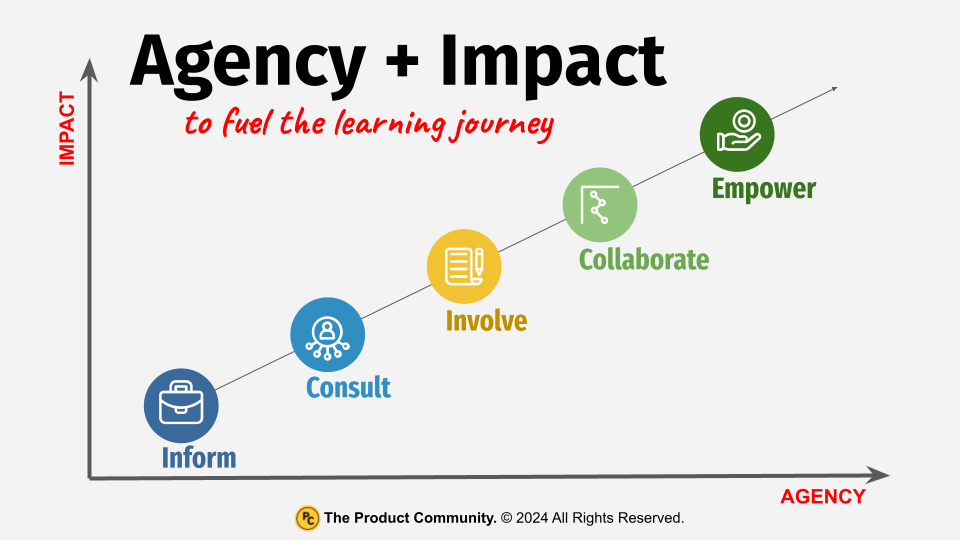Stackable Experiences
An Authentic Approach to Lifelong Learning
Summary
I wrote a couple of articles to help associations frame the importance of professional development and how to design learning pathways to guide member journeys. This article builds on these by explaining a professional development journey from the perspective of the learner. Learning should be at the center all association strategy: it connects us to peers, furthers our careers, and positions us to create great focused value for an appetizing membership.
Learning is steeped in experience. The word experience derives from the Latin experiri, which means “to try or attempt.” This suggests active engagement, ongoing learning, and putting ourselves into new and novel environments. Taking a proactive approach to one’s learning journey gives us knowledge and skills while fueling agency, confidence, momentum, and a lifelong commitment to being ready for what’s next.
I lead the product community, which is a product development learning community designed specifically for associations.
What are Stackable Experiences?
“Gravitate as best you can, in every way you can, toward people who value genuine community.”
Alan Jacobs
When it comes to professional development, it's important to recognize that learning and growth occur across a continuum of experiences, relationships, and communities. The concept of stackable experiences captures this idea of a multifaceted learning journey that encompasses diverse aspects of our professional lives.
Stackable experiences can be reflected in a continuum of informal and formal experiences across these domains. Here are some examples:
Formal and Informal Communities
Informal communities: These are the organic networks or groups that individuals form based on shared interests, goals, or experiences, such as online forums, social media groups, or local meetups.
Formal communities: These are professional associations, industry organizations, or workplace communities that individuals join based on their profession, industry, or organizational affiliation.
Informal and Formal Learning Experiences
Informal learning experiences: These include on-the-job training, self-directed learning through reading, watching tutorials or webinars, attending conferences or workshops, seeking mentorship or coaching, and engaging in professional discussions or networking events.
Formal learning experiences: These encompass structured programs such as degree programs, certifications, professional courses, or company-sponsored training sessions.
Formal and Informal Relationships
Informal relationships: These are the organic connections and interactions with colleagues, friends, mentors, industry experts, or peers that develop naturally through shared interests, projects, or professional networks.
Formal relationships: These are structured relationships with managers, supervisors, teachers, or assigned mentors, that are typically defined by organizational roles or specific programs.
The stackable experiences approach recognizes that professionals can benefit from a combination of these diverse elements, weaving together different learning experiences, relationships, and community involvement to create a rich and well-rounded professional development journey.
By embracing both formal and informal opportunities across these spectra, we can cultivate a diverse set of skills, knowledge, and connections that contribute to growth and success in our chosen fields. And it is absolutely an open lane for associations: to use a framework that guides, connects, and helps stitch together a welcoming, anticipatory learning community. Let’s look at an example.
An Example of a Healthcare Practitioner
“What’s in greatest demand today isn’t analysis, but synthesis – seeing the big picture, crossing boundaries, and being able to combine disparate pieces into an arresting new whole.”
Daniel Pink
Healthcare practitioners are lifelong learners that need a longitudinal framework to help guide their journey. This will help us, as learning providers, anticipate their needs, design relevant yet adaptive pathways, build relationships, and measure the impact of learning on practice and outcomes over the lifecycle.
Learning isn’t stutter step; it’s fluid and ongoing. It, therefore, needs a scaffolding to help inform the journey. To illustrate this, let’s look at a member of a medical association.
The 21st century physician learner embraces continuous learning in order to stay current and adapt to a rapidly evolving healthcare landscape. To get a sense of the ambitious scope of a physician learning journey, here is a fictitious profile of a 21st century physician learner named Dr. Shane Tracey:
Patient-centric approach – Dr. Tracey understands that healthcare is not just about treating diseases but about providing holistic patient care. She strives to understand patients' backgrounds, beliefs, and preferences, and tailor her care accordingly.
Lifelong learning – With the exponential growth of medical knowledge and advancements in technology, Dr. Tracey actively seeks opportunities to learn by attending conferences, participating in continuing medical education (CME) programs, and engaging in self-directed learning.
Evidence-based practice – Dr. Tracey is adept at critically appraising and integrating the latest scientific evidence into clinical decision-making. She stays up-to-date with clinical practice guidelines, reviews the latest research findings, and applies this knowledge to prevent, diagnose, and treat patients.
Interprofessional collaboration – 21st century healthcare takes a multidisciplinary team approach. To ensure coordinated and comprehensive care, Dr. Tracey collaborates with other healthcare professionals (nurses, pharmacists, allied health professionals, etc.).
Technology integration – Dr. Tracey embraces the use of technology. She is proficient with electronic health records, telemedicine platforms, medical devices, data-driven medicine, and other digital tools to enhance patient care, streamline workflows, and improve communication.
Adaptability and resilience – The healthcare landscape is constantly changing, with new regulations, policies, and technologies emerging regularly. Dr. Tracey is adaptable and resilient, able to navigate complexity and adjust to new situations.
Leadership and advocacy – Dr. Tracey recognizes her role as a leader and advocate in the healthcare system. She actively participate in initiatives to improve patient outcomes, healthcare delivery, and community health, while advocating for policies and practices that prioritize patient well-being and equitable access to healthcare.
Commitment to professionalism – Dr. Tracey upholds the highest standards of professionalism, including ethical conduct, empathy, integrity, and a commitment to patient privacy and confidentiality.
In order to navigate the complexities of modern healthcare while providing patient-centered, evidence-based care in collaboration with other healthcare professionals, Dr. Tracey needs to be a versatile and adaptable lifelong learner. Here are the many ways she engages over the lifecycle. What’s important is the coherence provided by a personalized learning pathway.
Designing our associations to maximize access to community, relationships, and experience, positions learners for deep and long-lasting connection. It becomes a platform for associations to:
Build multifaceted relationships with member learners.
Heighten awareness of, and better empathize with, learners and their needs.
Develop an integrated plan to help us identify synergies and connections so we can respond holistically to learners.
Build personalized, integrative, and responsive learning pathways to foster openness, diversity, equity, and inclusion.
Design iterative feedback loops, in which we can predict journeys, collect data, measure progress, and evaluate performance.
Create and evaluate milestones to guide the learner and to anticipate and enhance the journey.
Connect dots for both learning providers and for learners across varied experiences.
Together, creating a platform for diverse stackable experiences provides an opportunity for learners to gain agency (through an active role in their learning) and exercise impact (connecting meaningfully to solve important problems).
Over time, learners (and the associations that serve them) evolve from being passively informed toward deeper involvement, collaboration, and empowerment.
All professions and industries continue to undergo transformational change. Associations will need new knowledge and adaptive capabilities to guide members on their professional learning journeys. From this, we will begin to see the compounding effect of our investments in member learning, community, experiences, and culture.
The Compound Effect of Learning
“Change motivates and challenges. It makes clear when things are obsolete. Most of all, change forces us to learn differently.”
Douglas Thomas and John Seely Brown
Learning is required for anyone looking to make an impact. Associations can play a unique connector role in guiding these professional learning journeys.
Taken together, teams of hungry learners eager to improve their skills, gain new experiences, and build lasting relationships create what’s most important to the indispensable association: an exciting and sustainable learning community.
To achieve this, we will need to reframe the value conversation away from traditional conceptions of member benefits towards a coordinated ecosystem that fosters robust, longitudinal learning journeys that anticipate and embrace the entirety of a professional’s career.
Building a learning culture in which pathways enable learners to stack learning experiences offers the promise of choice, flexibility, and connection. Associations that invest in learning are investing in community and impact. Over time, the outcome becomes deep relevance and continual renewal.
I lead the product community; we are a learning community because we believe great relationships help us create the value our members want. Remember, product-led growth fuels connection. Join the product community and flip your destiny.
About the Author
James Young is founder and chief learning officer of the product community®. Jim is an engaging trainer and leading thinker in the worlds of associations, learning communities, and product development. Prior to starting the product community®, Jim served as Chief Learning Officer at both the American College of Chest Physicians and the Society of College and University Planning. Please contact me for a conversation: james@productcommunity.us





